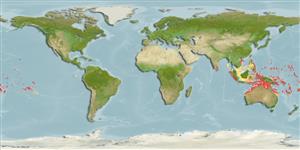Common names from other countries
>
Eupercaria/misc (Various families in series Eupercaria) >
Labridae (Wrasses) > Corinae
Etymology: Halichoeres: Greek, als, alis = salt + Greek, choiros = pig (Ref. 45335).
More on author: Randall.
Environment: milieu / climate zone / depth range / distribution range
Écologie
marin récifal; profondeur 10 - 56 m (Ref. 90102), usually 33 - ? m (Ref. 1602). Tropical; 19°N - 25°S
Indo-Pacific: Cocos-Keeling Island and Rowley Shoals in the eastern Indian Ocean to the Marquesas and Pitcairn islands.
Taille / Poids / Âge
Maturity: Lm ? range ? - ? cm
Max length : 24.0 cm TL mâle / non sexé; (Ref. 9710)
Description synthétique
Clés d'identification | Morphologie | Morphométrie
Épines dorsales (Total) : 9; Rayons mous dorsaux (Total) : 12; Épines anales: 3; Rayons mous anaux: 12; Vertèbres: 25. Fresh male specimens reddish brown dorsally, reddish ventrally; head with green bands; upper opercle with a large blue-edged black spot, rimmed with blue and red; 3 succession of spots behind eye. Large females may be similar in color with males but with a black spot on branched caudal rays; smaller ones have 3 black spots on dorsal fin base. Anterior lateral line scales with 2-7 pores, more in larger adults; 9-13 suborbital pores. Pelvic fins reaching or nearly reaching anus in large adults.
Common around patches of rubble or mixed rubble and coral along steep drop-offs (Ref. 1602) at 10-56 m depth (Ref. 90102). Feeds on benthic invertebrates (Ref. 89972).
Life cycle and mating behavior
Maturities | Reproduction | Spawnings | Egg(s) | Fecundities | Larves
Distinct pairing during breeding (Ref. 205).
Randall, J.E., G.R. Allen and R.C. Steene, 1990. Fishes of the Great Barrier Reef and Coral Sea. University of Hawaii Press, Honolulu, Hawaii. 506 p. (Ref. 2334)
Statut dans la liste rouge de l'IUCN (Ref. 130435)
CITES (Ref. 128078)
Not Evaluated
Menace pour l'homme
Harmless
Utilisations par l'homme
Pêcheries: commercial; Aquarium: Commercial
Outils
Articles particuliers
Télécharger en XML
Sources Internet
Estimates based on models
Preferred temperature (Ref.
115969): 25.1 - 28.3, mean 26.8 (based on 10 cells).
Phylogenetic diversity index (Ref.
82804): PD
50 = 0.5000 [Uniqueness, from 0.5 = low to 2.0 = high].
Bayesian length-weight: a=0.00955 (0.00451 - 0.02020), b=3.09 (2.92 - 3.26), in cm Total Length, based on LWR estimates for this Genus-body shape (Ref.
93245).
Niveau trophique (Ref.
69278): 3.5 ±0.37 se; based on food items.
Résilience (Ref.
120179): Milieu, temps minimum de doublement de population : 1,4 à 4,4 années (Preliminary K or Fecundity.).
Fishing Vulnerability (Ref.
59153): Low vulnerability (14 of 100).
